.
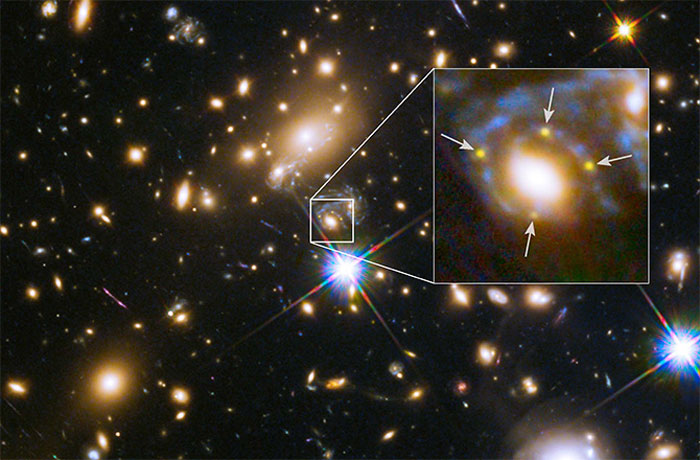
Four views of an ancient supernova are magnified by the gravity of a massive galaxy cluster lying between the supernova and the Hubble Space Telescope.
NASA/ESA/STSCI
Researchers using the Hubble Space Telescope took advantage of a naturally occurring zoom lens in space to capture an unprecedented quadruple image of an ancient supernova.
Between the supernova and the Earth-orbiting Hubble observatory lies a massive galaxy cluster whose gravity bends the path of the traveling photons. The existence of so-called “gravitational lenses” was proposed 100 years ago by physicist Albert Einstein. The first cosmic lens was discovered in 1979.
“Einstein’s theory of general relativity says that massive objects bend space and time. Light traveling close to massive objects will have their paths’ bent,” said astronomer Jennifer Lotz, with the Space Telescope Science Institute in Baltimore.
In addition to testing Einstein’s theory of relativity, this type of curved light could be used to measure how fast the universe is expanding.
Astronomer Patrick Kelly, with the University of California Berkeley, and colleagues report this week about four different routes light from an ancient supernova took to reach the Hubble telescope after being deflected around an intervening elliptical galaxy. The phenomenon is known as an Einstein cross.
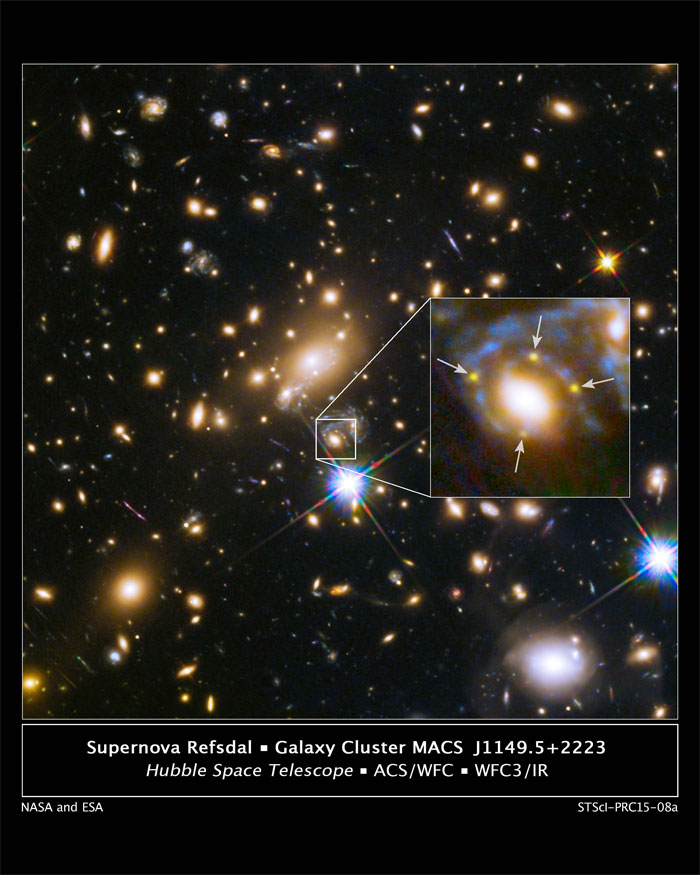
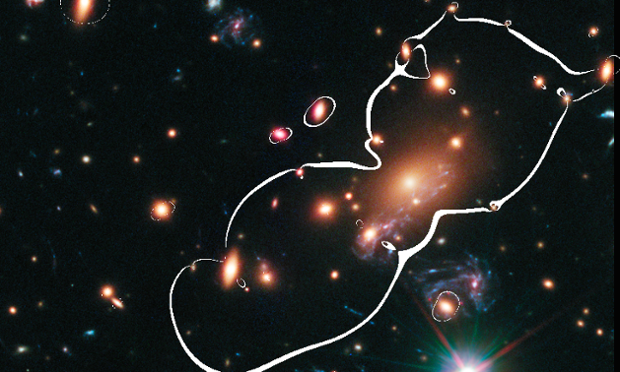
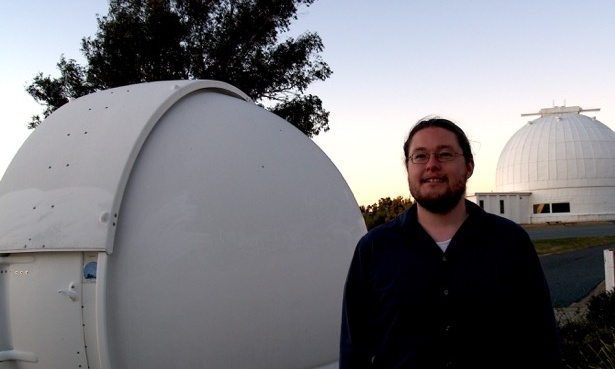
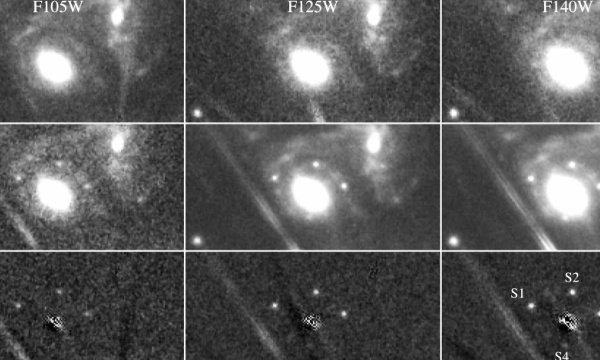
“Basically, we get to see the supernova four times and measure the time delays between its arrival in the different images, hopefully learning something about the supernova and the kind of star it exploded from, as well as about the gravitational lenses,” Kelly said in a statement.
The supernova will appear again in the next 10 years, as its light takes different paths around and through the gravitational lens.
The research is published in this week’s Science.

Quelle: D-News
.
Supernova 'kaleidoscope' seen for first time
Rare cosmic alignment produces images that could help to measure the expansion of the Universe.
Sometimes the stars really are aligned. A rare configuration of cosmic objects has produced the first kaleidoscopic image showing the same exploding star multiple times. If further images of the supernova appear, the system could provide a new way to measure the Universe's growth rate.
On 12 November last year, Patrick Kelly, an astronomer at the University of California, Berkeley, was looking for supernovae in images taken two days earlier by the Hubble Space Telescope. He found one, but it looked like no supernova that he or anyone else had ever seen: it appeared as four separate images in the same frame. He and his collaborators report the quadruple vision in Science1.
The images, which form a symmetrical arrangement known as an Einstein cross, came thanks to a rare line-up of objects that began with the supernova some 2.8 billion parsecs (9 billion light years) from Earth and ended with Hubble in Earth's orbit. In between lay a galaxy that was embedded within a larger cluster of galaxies about 1.5 billion parsecs (5 billion light years) away — both of which acted as cosmic magnifying lenses, bending and boosting the light from the exploding star. Light rays taking different paths around the lenses created the four different images.
The rare alignment may one day serve as a new cosmic yardstick. Determining distances in astronomy is a tricky business that often relies on inferring a supernova's actual brightness from its apparent one, a relationship that can be muddied by factors such as intervening dust. But pinning down distances is crucial because it allows astronomers to gauge how fast the Universe is expanding (the distance to a given object would be greater if the Universe were expanding faster).
The rate of expansion, known as the Hubble constant, provides a measure of the age and size of the Universe. Various methods have been used to measure the Hubble constant, but worryingly, they tend to arrive at slightly different values, so astronomers want to use every tool at their disposal to settle the question.
The latest yardstick takes advantage of the fact that the light rays from the supernova took different amounts of time to travel their different paths. Each image in the Warhol-light set appeared — and then showed the telltale rise and fall of the exploding star's light — at a staggered time. Measuring these delays can help to reveal the actual distance travelled by the light along each path.
A better measurement
Astronomers have used the same basic concept to measure the Hubble constant before, but instead of a supernova they have used multiple, lensed images of a bright, flickering type of object known as a quasar2. A supernova brightens and fades in a more predictable way than a quasar, which "should make it easier to measure the time delays", says Sherry Suyu, an astrophysicist at the Academia Sinica Institute of Astronomy and Astrophysics in Taipei, who has run the calculation using lensed quasars.
This particular supernova, named Refsdal after Sjur Refsdal, the Norwegian astrophysicist who proposed the lensing yardstick in 19643, may not offer such an improvement, however. The time delays between images depend not only on the different paths taken by the light rays, but also on the gravitational fields that the rays encounter along each path. And those fields are difficult to model in this double-lens system, because one of the lenses is a large and lumpy galaxy cluster.
The modelling could get better if light battling its way through the dense centre of the cluster emerges to form a new image of the supernova within the next decade, as the researchers expect. Exactly when the image appears will help researchers to pin down the distribution of matter in the cluster, and could lead to a measurement of the Hubble constant, says Kelly.
But it is not clear whether the Hubble Space Telescope will be looking at the cluster often enough in that time period to catch the image's arrival, says Adam Riess, an astronomer at Johns Hopkins University in Baltimore, Maryland, and a co-author of the latest paper. "It's hard to say how well you can measure the expansion rate with this," he says.
In any case, the chances of finding other matched sets of supernova images will improve when an observatory called the Large Synoptic Survey Telescope begins frequent sweeps of the southern sky4. The observatory is expected to open in 2022.
Quelle: nature
.
Images of star exploding four times captured by astronomers
Australian researchers were part of team able to capture images because of gravitational lensing, which magnified a supernova 9.3bn light years away

The supernova embedded within a galaxy cluster. Photograph: ANU
.
Australian researchers were among a team that captured images of the same star exploding four times, thanks to its location behind a massive cluster of galaxies.
The gravitational pull of the galaxies meant light and time were bent around them, creating a cosmic magnifying glass in a process known as gravitational lensing, which was first predicted by Albert Einstein’s theory of relativity. This magnified the supernova, which at 9.3bn light years away would have been too distant for the Hubble space telescope to detect were it not for this lensing effect.
Co-author of a paper from the Australian National University, Dr Brad Tucker, said it was the first time such an explosion had been captured multiple times.
.

Brad Tucker said it was the first time such an explosion had been captured multiple times. Photograph: ANU
.
Computer modelling suggested that the researchers missed opportunities to see the supernova 50 years ago and again 10 years ago, but the images would likely repeat in five years, the study published in the international journal Science on Friday said.
“It means we can wait for these appearances to replay over time and measure directly how much space has grown in that intervening time,” Tucker said. “The other exciting aspect of this discovery is that while we know the universe is accelerating, it hasn’t always been. It slowed down before it sped up.
“We found this star travelled through the period where the universe was moving from slowing down to speeding up, and we can now probe this part of the universe which we currently don’t have many measurements for.”
.

Multiple images of highly magnified supernova Photograph: ANU
.
The first gravitational lens was discovered in 1979 and since then, astronomers have discovered the universe is filled with them. While it was predicted that a supernova could be gravitationally lensed, Tucker and his colleagues provided the first example of it.
“It’s a relic of a simpler time, when the universe was still slowing down and dark energy was not doing crazy stuff,” Tucker said. “We can use that to work out how dark matter and dark energy have messed up the universe.”
The study, which also involved the University of Melbourne, was led by astronomer Dr Patrick Kelly from the University of California in the US. Kelly discovered the lensed supernova in November last year by luck, while looking for interesting explosions during separate research.
“We can get magnifications of up to 100 times by looking through these galaxy clusters,” Kelly said. “By luck, we have been able to follow it very closely in all four images, getting data every two to three days.”
Quelle: theguardian
4730 Views
